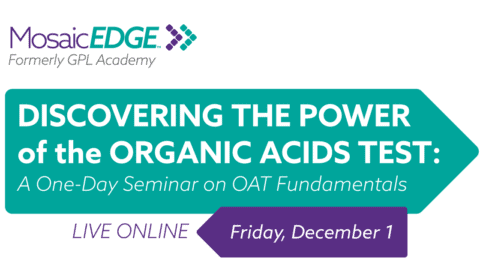In today’s developed and developing worlds, inflammation is on the rise. Inflammation is a protective mechanism employed by our bodies when being attacked or under stress. Acutely, inflammation is protective. Chronic inflammation is what contributes to long-standing chronic disease. With the ease of eating on the go and the abundance of fast food, foods that feed inflammation are on the rise in the diet of the modern individual. Also, the inflammatory nature of chronic conditions makes it imperative for healthcare professionals to know the importance of anti-inflammatories in the healing process. At Mosaic Diagnostics, we offer an easy-to-use profile, the Omega-3 Index Complete Test. This test is a dried blood spot (DBS), meaning easy collection for clients in the comfort of their home. With this ease of use, it’s never been easier to get a comprehensive look at someone’s fatty acid status. The test gives you the percentage of your omega 3 fats, the ratio of omega 6 fats to omega 3 fats, and a closer look at the ratio of arachidonic acid (AA) to eicosapentaenoic acid (EPA). At the end of each report, there is a nice breakdown of various fats and their percentage in your blood. Here is a link to a sample report.
Those who would benefit from getting a report include anyone with a chronic disease or looking to improve their overall health profile. Common conditions the research and clinical experience have been effective in providing efficacy of omega fats are cardiovascular disease, myocardial infarction (3), autoimmune conditions like multiple sclerosis (MS) and rheumatoid arthritis (RA) (2), skin conditions (4), mental health complaints like schizophrenia (7) and depression (10), Autism Spectrum Disorders (1), ADHD (1), and Alzheimer’s and traumatic brain injury (8). Various phases of life also require omega fats. A very critical stage is during gestation, infancy, and childhood development. Also, any individual looking to support reduction of inflammatory markers like tumor necrosis factor-alpha (TNF-alpha), interleukin-2 (IL-2), phospholipase A2, etc. and anyone looking to optimize health should consider this profile. This pairs with our Organic Acids Test as inflammation is a trigger of mitochondrial dysfunction, which you can see in the mitochondrial sections of this test.
Omega Fats and Common Conditions
Research has shown great benefits in omega 3 supplements as an addition to various disease states. Most common omega fats have been studied in reducing the incidence of cardiovascular events. Most of the research is focused on the reduction of total cholesterol. Omega 3 fats have been shown to reduce LDL-C and triglycerides, which are implicated in cardiovascular events (5). The addition of alpha-linolenic acid (ALA) has shown promising results in reducing the incidence of arrhythmias (3). In relation to mental health, omega fats are often seen to be reduced in the blood of those diagnosed with schizophrenia. Various mechanisms are thought to play a role in the reduction of omega 3s, especially DHA. The level of DHA in mental health is crucial to understand as 60% of the brain is constituted of phospholipids and 40% of those are DHA. This is often deficient in schizophrenic patients. In some cases, it’s a genetic misincorporation of DHA as there is a fatty acid binding protein preference for more in inflammatory omega 6 fatty acids (7). This leads to an increased omega 6:3 ratio. In most cases, these patients have been noted to eat a more inflammatory diet, devoid of omega 3 rich foods (14). In depression, the addition of omega DHA and EPA has been shown to improve mood. This is also seen in perinatal and postpartum depression when given in combination with other traditional therapies. In Autism Spectrum Disorders, blood levels of fatty acids show increased omega 6 PUFA in comparison to omega 3. This equates to an elevated omega 6:3 ratio (12). More studies with larger sample sizes are needed to further the research in autism even though many clinical benefits have been seen with omega fat administration (1).
Autoimmune conditions also have a plethora of research connecting the benefits of omega-rich fats. In RA patients taking omega 3 fats, reduction of analgesics was achieved without changes in weight when it came to joint pain. Various studies have shown improved joint pain with the addition of DHA and EPA. A positive effect on swelling and morning stiffness in the joints. Most of these benefits were seen after 12 weeks of seafood intake and/or fish oil supplementation. In SLE 2.25g of both EPA and DHA, after 12 weeks of supplementation, inflammatory markers IL-13 and L-12 were significantly decreased. The inverse was seen in high carb low PUFA diets (17). AA:EPA ratios were also higher in SLE patients with fewer symptoms and lower inflammation markers (9). This was seen in those whose diet reflected higher omega 3 intake, even without supplementation. In type 1 diabetes, CRP was lower in infants that were breastfed and supplemented with DHA than formula-fed infants (1). Daily EPA and DHA in the first year of life also significantly reduced the chance of developing T1DM. Omega 3’s also showed efficacy in blocking the pro-inflammatory PGE2 on beta-cells in the pancreas, leading to increased insulin secretion (18). In those with Type 2 diabetes levels of TNF-alpha and IL-2 were significantly decreased in omega 3 supplementation groups (11). These are just a few examples of the efficacy of omega fatty acids in autoimmunity.
In the dermatologic world, omega fats are used routinely. The skin is the outermost barrier of the body. Fatty acids play a role in the reduction of Transepidermal water loss (TEWL). This is often elevated in conditions related to dry skin. Atopic dermatitis (AD), psoriasis, and acne are all common skin conditions supported by the addition of omega fats. In AD infants fed breast milk low in omega 3 fats had a higher incidence. After 90 days of DHA/EPA supplementation, there was a detectable 30% increase in cutaneous hydration and itch-related behavior was eliminated. Gamma linolenic acid (GLA), an omega 6 fatty acid, when used for 4 weeks orally showed a lower TEWL and higher stratum corneum index. When given with omega 3 fats the production of a more inflammatory omega 6, AA, is inhibited (4). This is promising in the treatment of AD and both omega 3s and 6s should be given together. In psoriasis, low levels are seen in individuals with a diet, or ancestral diet, high in omega 3s like in the Eskimo population. In the pathogenesis of acne, C. acnes induces proinflammatory cytokine release of cytokines including IL-1β, TNF-α, IL-8, and IL-12. This is induced through the toll-like receptor 2 (TLR-2) signaling pathway (4). DHA and EPA inhibit TLR-2 and thus supplementation reduces the proinflammatory nature of acne. Insulin growth like factor-1 (IGF-1) is another signaling pathway that directly affects keratinocytes and is blocked by omega 3 fatty acids (4). As we can see various conditions are supported by the introduction of omega fatty acids.
Ratios
The Omega 3 Test also supplies information regarding important omega fat ratios. Specifically tested are the omega 6:3 and AA:EPA ratios. Ideally, both ratios should be low. As we saw above, the balance between omega 6 and 3 fats is crucial in many disease states. The Omega 6: 3 ratio in the developed world tends to be much higher than optimal health would support. This is due to the abundance of omega 6 rich foods in the diet. Concurrently, there is a substantial lack of omega 3s in the diet. Common foods like chips, snack cakes, and fast foods are readily available and cooked in oils high in omega 6. When improperly balanced with omega 3s an environment of inflammation is created. On average the ratio seen in most individuals is upwards of 15-17:1 and higher results have been documented. In asthma, a ratio of 5:1 correlates with decreased airway inflammation and improved clinical outcomes (19). In contrast, a ratio of 2-3:1 was helpful in RA. 10:1 ratio was seen as detrimental in both conditions. The differences in ratios for each condition opens the thought process that the ratio optimization will depend on the condition and also the level in which the client in question is currently trending. Testing is the best way to understand where each client’s ratio stands pre-treatment.
In cases of obesity, omega 6 rich and omega 3 devoid diets increase triglyceride levels. This pattern also leads to disruption in leptin regulation. Leptin helps to regulate the feeling of fullness. When dysregulated we have an increased consumption of calories. This phenomenon is seen as early as the perinatal period. Cord blood of infants with high omega 6:3 was seen to have increased subscapular skinfold thickness by age 3. Also, obese/overweight children were shown to have a higher level of blood AA levels. The good news is that a correction of this ratio, or lowering of it, was shown to help with the treatment of obesity. Regarding autism and ADHD, an elevated AA/EPA is consistent with affected children. In our immune cells, a Western 9diet increases the AA to about 20% while DHA and EPA reduce to 1-2%. This leads to increased production of inflammatory 2,4-series eicosanoids. But the addition of EPA/DHA supplementation will decrease AA-derived eicosanoids and increase the anti-inflammatory 3/5-series eicosanoids (6). So, by increasing the omega 3 rich foods and/or supplementation the inflammatory nature of the immune system can be greatly affected for the better.
Overall, our need for omega fats is clear. Their support in creating an anti-inflammatory environment reduces our risk of chronic disease. The addition of them during a chronic disease state can aid in the treatment of the condition. The research clearly shows the importance of balancing the omega 3s and 6s in the treatment of certain diseases. More research needs to be done to know the exact ratios for optimal overall health and other specific disease conditions. By utilizing the Omega-3 Index Complete Test, we as practitioners can guide our clients to the right omega balance for them and their conditions. This profile should be considered in any chronic disease client. If we are encouraging the intake of omega 3 rich foods, health is being well supported.


References
Agostoni, C., Nobile, M., Ciappolino, V., Delvecchio, G., Tesei, A., Turolo, S., Crippa, A., Mazzocchi, A., Altamura, C. A., & Brambilla, P. (2017, December 4). The role of omega-3 fatty acids in developmental psychopathology: A systematic review on early psychosis, autism, and ADHD. International journal of molecular sciences. Retrieved December 23, 2021, from https://www.ncbi.nlm.nih.gov/pmc/articles/PMC5751211/AP;, S. (n.d.). Omega-3 fatty acids in inflammation and autoimmune diseases. Journal of the American College of Nutrition. Retrieved December 23, 2021, from https://pubmed.ncbi.nlm.nih.gov/12480795/A., J. R. Nelson & S. Raskin, & Additional informationFundingThis article was funded by Amarin Pharma Inc. (n.d.). The eicosapentaenoic acid:arachidonic acid ratio and its clinical utility in cardiovascular disease. Taylor & Francis. Retrieved December 23, 2021, from https://www.tandfonline.com/doi/full/10.1080/00325481.2019.1607414Balić, A., Vlašić, D., Žužul, K., Marinović, B., & Bukvić Mokos, Z. (2020, January 23). Omega-3 versus omega-6 polyunsaturated fatty acids in the prevention and treatment of inflammatory skin diseases. International journal of molecular sciences. Retrieved December 23, 2021, from https://www.ncbi.nlm.nih.gov/pmc/articles/PMC7037798/Bradberry, J. C., & Hilleman, D. E. (2013, November). Overview of omega-3 fatty acid therapies. P & T : a peer-reviewed journal for formulary management. Retrieved December 23, 2021, from https://www.ncbi.nlm.nih.gov/pmc/articles/PMC3875260/DiNicolantonio, J. J., & O'Keefe, J. (2020). The importance of maintaining a low omega-6/omega-3 ratio for reducing the risk of inflammatory cytokine storms. Missouri medicine. Retrieved December 23, 2021, from https://www.ncbi.nlm.nih.gov/pmc/articles/PMC7721408/Hsu, M.-C., Huang, Y.-S., & Ouyang, W.-C. (2020, July 3). Beneficial effects of omega-3 fatty acid supplementation in schizophrenia: Possible mechanisms. Lipids in health and disease. Retrieved December 23, 2021, from https://www.ncbi.nlm.nih.gov/pmc/articles/PMC7333328/Kumar, P. R., Essa, M. M., Al-Adawi, S., Dradekh, G., Memon, M. A., Akbar, M., & Manivasagam, T. (2014, April). Omega-3 fatty acids could alleviate the risks of traumatic brain injury - a mini review. Journal of traditional and complementary medicine. Retrieved December 23, 2021, from https://www.ncbi.nlm.nih.gov/pmc/articles/PMC4003707/Li X;Bi X;Wang S;Zhang Z;Li F;Zhao AZ; (n.d.). Therapeutic potential of ω-3 polyunsaturated fatty acids in human autoimmune diseases. Frontiers in immunology. Retrieved December 23, 2021, from https://pubmed.ncbi.nlm.nih.gov/31611873/Liao Y;Xie B;Zhang H;He Q;Guo L;Subramanieapillai M;Fan B;Lu C;McIntyre RS; (n.d.). Efficacy of omega-3 pufas in depression: A meta-analysis. Translational psychiatry. Retrieved December 23, 2021, from https://pubmed.ncbi.nlm.nih.gov/31383846/Malekshahi Moghadam A;Saedisomeolia A;Djalali M;Djazayery A;Pooya S;Sojoudi F; (n.d.). Efficacy of omega-3 fatty acid supplementation on serum levels of tumour necrosis factor-alpha, C-reactive protein and interleukin-2 in type 2 diabetes mellitus patients. Singapore medical journal. Retrieved December 23, 2021, from https://pubmed.ncbi.nlm.nih.gov/23023905/Mocking RJT;Steijn K;Roos C;Assies J;Bergink V;Ruhé HG;Schene AH; (n.d.). Omega-3 fatty acid supplementation for perinatal depression: A meta-analysis. The Journal of clinical psychiatry. Retrieved December 23, 2021, from https://pubmed.ncbi.nlm.nih.gov/32898343/Omega-3 fatty acids: An essential contribution. The Nutrition Source. (2019, May 22). Retrieved December 23, 2021, from https://www.hsph.harvard.edu/nutritionsource/what-should-you-eat/fats-and-cholesterol/types-of-fat/omega-3-fats/PC;, C. (n.d.). Dietary modification of inflammation with lipids. The Proceedings of the Nutrition Society. Retrieved December 23, 2021, from https://pubmed.ncbi.nlm.nih.gov/12296294/PC;, C. (n.d.). Omega-3 fatty acids and inflammatory processes: From molecules to man. Biochemical Society transactions. Retrieved December 23, 2021, from https://pubmed.ncbi.nlm.nih.gov/28900017/PC;, C. (n.d.). Polyunsaturated fatty acids, inflammation, and immunity. Lipids. Retrieved December 23, 2021, from https://pubmed.ncbi.nlm.nih.gov/11724453/Rajaei, E., Mowla, K., Ghorbani, A., Bahadoram, S., Bahadoram, M., & Dargahi-Malamir, M. (2015, November 3). The effect of omega-3 fatty acids in patients with active rheumatoid arthritis receiving dmards therapy: Double-blind randomized controlled trial. Global journal of health science. Retrieved December 23, 2021, from https://www.ncbi.nlm.nih.gov/pmc/articles/PMC4965662/Shaw, W. (1985). Possible role of lysolecithins and nonesterified fatty acids in the pathogenesis of Reye's syndrome, sudden infant death syndrome, acute pancreatitis, and diabetic ketoacidosis. Clinical Chemistry, 31(7), 1109–1115. https://doi.org/10.1093/clinchem/31.7.1109Simopoulos, A. P. (2002, September 11). The importance of the ratio of omega-6/omega-3 essential fatty acids. Biomedicine & Pharmacotherapy. Retrieved December 23, 2021, from https://www.sciencedirect.com/science/article/abs/pii/S0753332202002536




